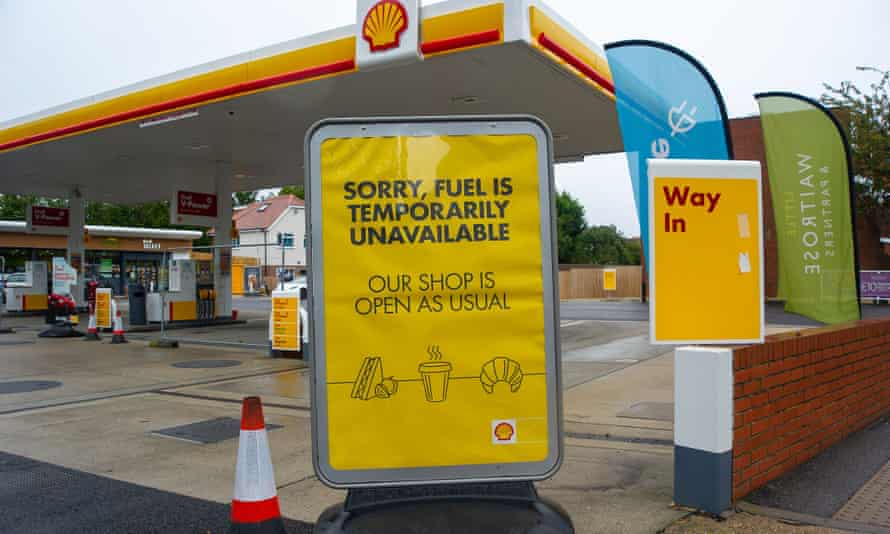Fuel crisis and supply shortages are a product of the UK’s economic model

Rising prices and lack of goods are what happens when just-in-time economy collides with skin-of-the-pants government

It all seems to have happened so fast. Only a few months ago, the government was congratulating itself for the speed at which Britain was emerging from the pandemic. But as the nights have lengthened, there have been empty shelves at supermarkets, spiralling energy prices and queues snaking back from petrol stations.
If there is a general sense of bemusement at all this, then there really shouldn’t be. This is what happens when just-in-time production methods collide with just-in-time government and turn a problem into a crisis.
Lessons have clearly not been learned from the financial crisis of 2008. Then, it was just-in-time banking that had its fundamental weakness exposed; namely that institutions had insufficient reserves of capital to absorb losses. Now a similar problem has affected production supply chains; there is not enough slack in the system to cope with an unexpected shock.
Just-in-time supply chains were designed around lean production and minimal inventories as a way of cutting back on waste and costs. But while management consultants loved them, they really only functioned in the good times. In the case of car production, the problem was a shortage of computer chips. In the case of energy, supplies of gas could not keep up with demand – especially from Asia – as economic recoveries took hold.
No country in the world has been immune from supply bottlenecks, but Britain has suffered more than most. The reason for that is that a skin-of-the-pants approach is hardwired into the British system of governance, with an almost complete lack of planning and a messianic belief in market forces.
The lack of HGV drivers is a case in point. The haulage industry has been warning of problems for more than half a decade, telling ministers that more drivers were leaving the industry than joining it, and that the shortages would be exacerbated by Brexit. The government did nothing, even when the problem was compounded by the pandemic, and have responded by offering 5,000 temporary visas to overseas lorry drivers. This is a classic case of too little, too late. It will be interesting to see how many drivers will be attracted to the UK by the lure of (at most) two months’ work. Well short of 5,000 in all likelihood.
Ultimately, market forces will work. If the wages on offer are raised sufficiently, the supply of new drivers will increase and the shortages will disappear. But they may not arrive in time to keep supermarket shelves stocked for Christmas.
Similarly, the reason the UK is entering the winter with its lowest stocks of gas in a decade is because of a lack of storage. This follows the closure in 2017 of the Rough facility, which provided 70% of the UK’s storage capacity for 30 years, as a result of a government decision not to subsidise the costly maintenance and upgrades needed to keep the site going.
Britain now has just 1% of Europe’s storage capacity, enough to cope with four or five cold winter days.
Sometimes the government gets it right. The furlough, put together at rapid pace in the emergency conditions of March 2020 when the UK was facing mass unemployment, is an example of just-in-time policymaking that worked. The success of wage subsidies is the exception not the rule, however. The cobbled-together scheme for dealing with NHS waiting lists and long-term social care needs is far more typical.
Business tends to be quicker than officialdom at spotting trends and was already adjusting to a post-just-in-time world before the Covid-19 crisis. After decades of offshoring, production is being brought back onshore for four key reasons: the cost benefits are no longer as great as they were; a sense that shorter supply chains mean less vulnerability to external events; a growing fear of China; and pressure to reduce carbon footprints.
But governments – including the UK government – are starting to get the message. Britain’s relations with China are much cooler than they were when David Cameron was prime minister and Brexit has led to a willingness to embrace state aid and industrial policy.
The real test, though, is still to come, because having made the transition from a manufacturing to a service sector dominated in the late 20th century, the coming years are supposed to see the transition to a low-carbon economy.
The former coalfields and the old industrial heartlands of south Wales, the central belt of Scotland, and the northern regions of England are still scarred by the shock treatment administered in the 1970s, 80s and early 90s. Only after factories had been bulldozed and pits shut was much thought given to what those affected by the loss of their livelihoods would do next. Eventually, low-paid insecure jobs took the place of well-paid unionised employment as call centres replaced the collieries.
The damage to those communities has never been remotely repaired, and that should be a lesson to the current generation of policymakers because the transition to a low-carbon economy will be an equally painful affair if not handled with extreme care.
One small benefit from the current chaos is that it should act as a warning of proceeding without a plan. The transition requires time, sensitivity, investment, collaboration between the public and private sectors, and a willingness to learn from past mistakes.
It is a fantasy to expect such a profound change in the economy to happen without substantial disruption. The real question is whether the disruption is so painful that public support for net zero drains away. What’s certain is that just-in-time won’t cut it.